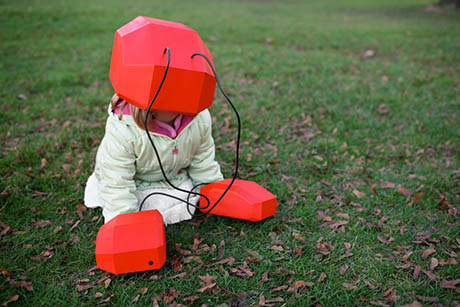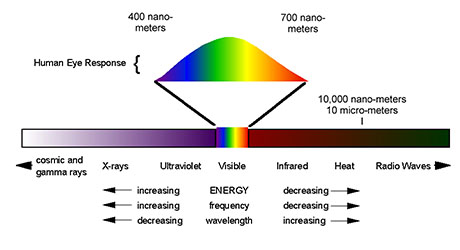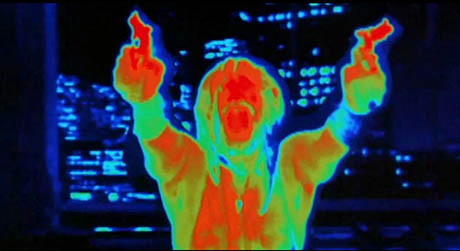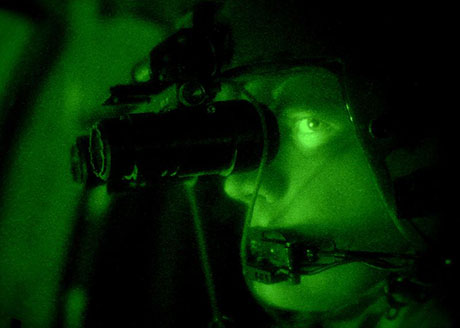The better part of an aisle of in most pharmacies and supermarkets is usually dedicated to dietary supplements: vitamins, minerals, and extracts that promise various flavours of biological optimisation, from an immune system boost to healthy joints or even stronger fingernails. Even a trip to Starbucks offers the option of ingesting substances that will speed up your metabolism (green tea) or your brain (caffeine).

IMAGE: Vitamins, via.
But what if tweaking your diet could go beyond improving what you were born with, and instead endow your body with entirely new capabilities?
A recent article on the BBC surveyed a subculture within the bio-hacking movement, in which humans attempt to acquire animal sensory perception.
At the relatively tame, though still awe-inspiring, end of the scale, we find a handful of blind people who have developed the ability to navigate their environment using echolocation. Of course, their tongue clicks are within the human acoustic range, unlike the ultrasound squeaks of bat or dolphin sonar. Nonetheless, through careful training, their perceptual world has been expanded beyond the limits of the typical human sensory apparatus.

Animal Superpowers, 2008, Chris Woebken and Kenichi Okada.
Another approach is to use prosthetics. Chris Woebken and Kenichi Okada’s Animal Superpowers, for example, is a range of brightly coloured wearable devices give children the temporary ability to emulate ant, giraffe, and bird perception.
Still others take the plunge into full-on bodily modification. Peyton Rowlands, a 19-year-old member of citizen biohacking collective Science for the Masses, inserted a neodymium magnet under the skin of the middle finger of his left hand in an attempt to mimic the ability of birds, sharks, and bacteria to detect magnetic fields.

IMAGE: Peyton Rowlands with his bandaged magnet finger, via.
Although the procedure sounds rather excruciating — he performed the insertion without anaesthetic, and his body eventually rejected the magnet—the resulting perceptual shifts were fascinating. As Rowlands told the BBC, thus equipped with magnetoception, his environment resonated with the otherwise invisible vibrations of electrical current, rising and falling with proximity to household electronics and pylons:
You feel a slight buzz once you get within a couple of inches of basically anything with electricity running through it. It’s a very interesting sensation, kind of crazy. One of the things that I noticed is that DC current often felt similar to a ferrous metal or another magnet, a static bubble pushing or pulling against you, as opposed to AC currents which were much more like the kind of pins and needles feeling people describe.
Rowland’s latest project, however, does not rely on training, prosthetic additions, or physical modification. Instead, it could be described as dietary bio-hacking. By cutting retinal (part of the Vitamin A complex) out of his diet, he is hoping to force his body to develop near-infrared vision.
It is — if it works — a dietary anti-supplement that bestows sensory superpowers.

IMAGE: Electromagnetic spectrum via the Universities Space Research Association.
The strategy is inspired by tilapia (and other freshwater fish), which use a different form of Vitamin A, dehydroretinal, to bind with their opsins (the retina-based proteins that turn light into an electrochemical signal). In humans, opsins preferentially bind with retinal to form rhodopsin; in freshwater fish, it’s more common for dehydroretinal and opsin combine to form porphyropsin. The difference between the two light-sensitive visual pigments is small at the blue end of the spectrum, but porphyropsin is progressively more sensitive than rhodopsin at longer wavelengths.
The result is that freshwater fish can spot tasty infrared-reflective shrimp in murky lakes and streams, and humans cannot.
Because the human body is capable of metabolising and using dehydroretinal, if forced, Peyton Rowlands and his Science for the Masses colleagues have reasoned that a diet that cuts out all retinal but contains dehydroretinal will enable them to see a tiny bit beyond normal human vision, into the near edge of the infrared band.

IMAGE: Image from Predator 2, via.
What would that mean? Not Predator-style heat vision, unfortunately — if it works, this near-infrared augmentation would only extend a human’s visible light spectrum from its current edge at about 700 nanometres up to 790, which is not sufficient to detect thermal traces at room temperature.
Instead, according to Jeffrey Tibbets, Science for the Masses’ medical expert, this diet-enhanced vision would be more akin to Sony’s Nightshot feature — the infamous filter that users quickly realised allowed them to see through people’s clothing. Beyond naked humans, however, by following this alternative-A diet, Tibbets expects that:
A person would be enabled to see through darkly tinted car windows, or sunglasses with ease. Although investigators generally use ultraviolet light to pick up body fluid stains, infrared works just as well. Even old faded papyrus manuscripts and otherwise illegible faded books would be an easy feat for our augmented friend. One limiting factor of how far a person can see is the amount of particulate matter in the air. Infrared light cuts through fog, haze, and dust to a degree that would enable this person to have much sharper vision at a distance than a non-augmented human.

IMAGE: Sony’s NightShot feature in action, via.
Not everyone is so sure that dietary superpowers can be so easily achieved, arguing (both persuasively and poetically) that the eye will only see itself — that a device built of warm-blooded cells will blind itself with its own thermal signature. There’s also a concern that, whether or not humans can develop the physical ability to detect IR in our environment, we can’t evolve the neural structures to translate it into a comprehensible visual signal quickly enough.
On the other hand, Tibbets points out that he and his bio-hacking colleagues are merely following in the footsteps of the United States Navy, which apparently already successfully tried this experiment on sailors during World War II.
They fed their sailor guinea-pigs with a diet low in normal sources of Vitamin A but supplemented with the livers of walleyed pikes, and, according to Perception, a psychology textbook, “over several months, the volunteers’ vision changed, giving them greater sensitivity to light of longer wavelengths.”

IMAGE: The infrared-detecting sniperscope from the June 1946 issue of Popular Science.

IMAGE: Today’s Aviator Night Vision Imaging System (ANVIS) AN/AVS-6, courtesy PEO Soldier.
The experiment was aborted, however, when researchers developed primitive “image converter tubes” — the predecessor of today’s nightvision goggles — that translated infrared light into the visible spectrum. The wearable device beat the bio-hack: the mechanically augmented human took precedence over the diet-adapted one.
Technological enhancements and cyborg transhumanism aside, however, it’s somewhat fascinating to reflect on the way in which our diet generates our perceptual universe, which in turn is precisely tuned to the luminosity of our environment.

IMAGE: Vintage Violence, North Kivu, Eastern Congo, 2011, from Infra by Richard Mosse. Mosse uses a discontinued infrared film called Kodak Aerochrome to document the contested and bloody landscape of the Democratic Republic of Congo.
The wavelength of the peak irradiance of sunlight on earth surface is 500 nanometres (the same is true of moonlight, which is simply reflected sunlight), which happens to be the peak absorbence of rhodopsin, meaning that the retinal in our diet is perfectly adapted to give us maximum sensitivity to available natural light.
But the different structures of Vitamin A allow for a sort of “spectral tuning,” exploited by fish , and perhaps soon Peyton Rowlands, to adapt their vision to the murkier haze of underwater — or, indeed, contemporary — life.

